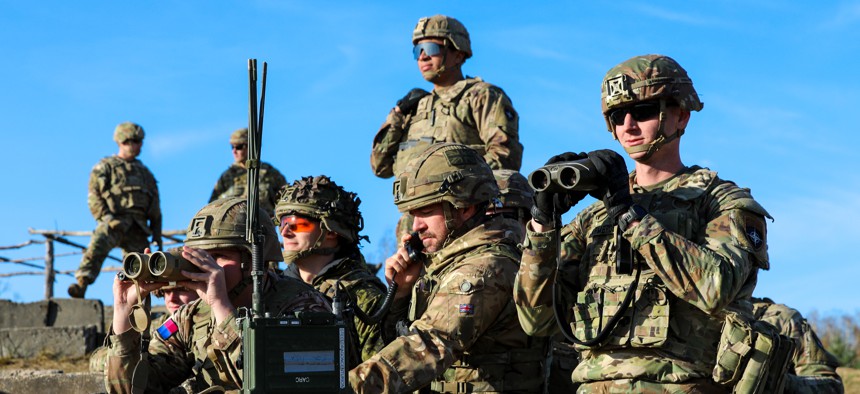
Soliders with NATO's enhanced Forward Presence Battlegroup Poland take part in a live-fire exercise in Toruń, Poland, on Nov. 3, 2022. U.S. Army National Guard photo by Sgt. Gavin K. Ching
NATO’s defense demands Eastern Front improvements
The recent summit largely avoided urgent questions about the mismatch between available forces and the Russian threat.
Ukrainian President Volodymyr Zelenskyy’s rather impolitic reaction to the news that his country would not receive a firm timetable for membership in NATO stole the show at the alliance’s summit in Vilnius last week. Receiving far less attention, but of arguably more immediate importance is the mismatch between the alliance’s forces in Eastern Europe and its strategy for meeting the Russian threat.
NATO has been rather slowly adapting its force structure in Eastern Europe since Russia’s first invasion of Ukraine in 2014. In 2016, the alliance launched enhanced Forward Presence, a plan to deploy rotational battlegroups to eastern members. Within a year, four multinational units of roughly 1,200 troops apiece had arrived in Estonia, Latvia, Lithuania, and Poland. The alliance expanded eFP after Russia’s second invasion of Ukraine last year, expanding the existing units to as many as 1,900 troops and dispatching new units to Slovakia, Hungary, Bulgaria, and Romania.
At the alliance’s June 2022 summit, NATO also changed its strategy for meeting a Russian invasion. Instead of fighting to slow the enemy advance until more friendly forces can join the fight, alliance members decided that they would work to deny any gains at all on allied territory.
But the eFP units arrayed across Eastern Europe are not fit for purpose, with shortcomings in scale, capabilities, interoperability, and readiness. In a crisis, reinforcements would be needed from across the continent (and the pond). But NATO leaders might hesitate to send them before an invasion to avoid appearing escalatory, and they would struggle to move them afterward, given Europe’s impediments to military mobility.
The situation has become particularly problematic given Russia’s decision to station tactical nuclear weapons in Belarus and reports that Wagner may reconstitute itself there as well. The question remains: how can NATO keep Vilnius, Tallinn, Riga, or any other allied city from becoming the next Bucha?
To fulfill its strategy of denial, NATO must address four major eFP shortcomings in time for the next summit in 2024 in Washington.
First, eFP units must be larger. NATO doesn’t need to match Russians across the border troop for troop, but it must come closer in the three Baltic states and Poland. eFP units in these four countries should be full brigades of roughly 4,000 to 5,000 troops. Meanwhile, it remains a mystery why the alliance thinks it needs land-centric eFP units of any size in Slovakia, Hungary, or Bulgaria, where a Russian ground force incursion seems improbable—better to use these resources elsewhere. And as for the unit in Romania, NATO ought to shift its purpose and structure from land domain defense to intelligence, counter-electronic warfare, and counter-submarine activities, given the nature of the Russian threat in the Black Sea region.
Second, eFP units lack the capabilities they need to execute the denial strategy. For example, NATO air policing missions currently run 24/7, but are limited in scope. Similarly, eFP units often lack state-of-the-art electronic-warfare capabilities, a known strength of Russia’s military. Incorporating integrated air and missile defense, counter-UAV, and defensive and offensive electronic warfare capabilities into eFP units would strengthen their ability to deny Russia initial gains in any short-notice attack.
Third, the multinational character of some eFP units undermines their ability to operate effectively. A lack of common equipment, varying operational limitations imposed by multiple contributing countries, and disparate English language capabilities frustrate interoperability below the battalion level. Although multinationality reflects solidarity across the alliance, in post-2022 Europe, military effectiveness must take priority over political signaling. Therefore, NATO should not permit any eFP contributions of less than full battalions (up to about 1,000 troops).
Finally, eFP units lack a single, fully consistent standard for readiness. For instance, in some cases, eFP subunits do not conduct collective training before their deployment to one of the host nations. In other cases, participating nations vary what they contribute to each eFP rotation. And in some instances, subunit rotations last for differing periods of time, undermining cohesion. All of this frustrates efforts to achieve “fight tonight” readiness across all eFP units. To fix this, NATO should build a single eFP-readiness standard that is tailored to the unique defense challenge confronting each eFP host nation but that is nonetheless centrally assessed by the alliance’s strategic commands in Mons, Belgium and Norfolk, Virginia.
Given the vital importance of the eFP mission, there’s no time to waste in preparing for the Washington summit next year, when the alliance will celebrate its 75th birthday. Strengthening and refining eFP should be high on the list of potential agenda items. By laying out a roadmap for refinement and improvement now, the alliance can deliver on the promise of collective defense by denial.
Gabriela R. A. Doyle is a nonresident fellow with the Atlantic Council’s Transatlantic Security Initiative.
John R. Deni is a research professor at the U.S. Army War College’s Strategic Studies Institute, a nonresident senior fellow at the Atlantic Council, and an associate fellow at the NATO Defence College. He’s the author of NATO and Article 5 (Rowman & Littlefield, 2017).
This article was prepared by the authors in their personal capacities. The views and opinions expressed in this article are those of the authors and do not necessarily reflect the official policy, opinion, or position of their employers.


